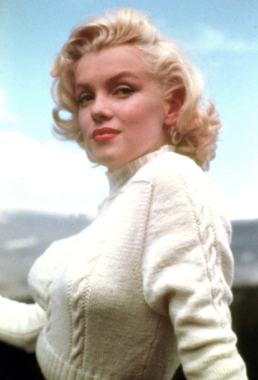These life stories may contain descriptions of childhood trauma and abuse, as well as images, voices and names of people now deceased. If you need help, you can find contact details for some relevant support services on our support page.
American icon, Marilyn Monroe (1926-1962), was in foster care, an orphanage and kinship care as a child.
Norma Jean Mortenson was born in Los Angeles, California to Gladys Monroe Baker, who worked in the film industry as a film cutter.
Gladys Baker suffered from post-natal depression and neglected her baby, putting the three-month-old into foster care with Ida Bolender who took in other foster children. Norma Jean felt a part of the Bolender family and the Bolenders wanted to adopt her but Gladys refused. Gladys did visit Norma Jean each weekend and took the girl on outings.
In 1933, Gladys retrieved her daughter, taking her to live in Hollywood, but the child went into foster care again, this time with the Atkinsons who were friends of Grace Goddard, Gladys’ friend. Gladys would take Norma Jean on outings as she did when the child was with the Bolenders.
In January 1934, not long after she had bought a house and rented some of it to the Atkinsons, Gladys was institutionalised. Norma Jean became a ward of the state, and Grace became Norma Jean’s guardian as well as Gladys’. Gladys was rarely visited by Grace and Norma Jean.
During the next eight years, until Norma Jean married in 1942 at the age of sixteen, Grace placed her in eleven foster homes and an orphanage (Banner, 13).
Norma Jean was sexually abused in several of those foster homes and hated the orphanage.
Norma Jean was very unhappy between the ages of nine and twelve, not only because of the moves but because she was made fun of at school – she was tall for her age and skinny, was laughed at because of her clothes, and because she said she was going to be an actor.
Watching movies, with her mother or with Grace or by herself, was one of Norma Jean’s favourite activities and she was influenced by Greta Garbo, Joan Crawford, and Jean Harlow.
When the girl was moved in with Ana Lower, her mother’s fifty-eight-year old aunt, Norma Jean was finally settled for four years.
Ana Lower was good for Norma Jean. She did not judge the child but instead encouraged Norma Jean in her schoolwork and in “her aspirations to become a film star” (Banner, 76).
Marilyn Monroe later stated that Ana had been a wholly positive influence.
“She changed my life. She was a wonderful human being” (Monroe cited by Banner, 79).
When she was 15, Norma Jean moved in with Grace and her husband, Doc. But in 1941 when Grace and Doc were moving so Doc could take up a new job, they did not know what to do with Norma Jean – neither the state nor Gladys would permit a move to the East Coast – so they organised for the teenager to marry Jim Dougherty on 19 June 1942. The couple rented a flat, and then she moved in with his parents in April 1944 when he went to serve in the South Pacific.
It was also in 1944 that Norma Jean took up modelling and she changed her name to Marilyn Monroe as her career began to take off.
She was a leading West Coast model within two years…and a contract player at Twentieth Century-Fox by 1946. It took her six more years to achieve stardom, but demonstrated creativity, guts, and a major ability at manipulation in achieving it (Banner, 101).
Marilyn Monroe began taking acting lessons with Lee Strasberg in 1955 and Sam Kashner suggests Strasberg became a “beloved paternal figure, autocratic, yet nurturing and gave her the training to improve her acting, and turned her from a movie star (and punch line) into a true artist.”
During the 1950s, Marilyn Monroe was not only a popular ‘sex symbol’ but more famous than other entertainers. Her movies – twenty-three of them – grossed more than $23 million.
Adult life was not easy for Marilyn Monroe because of her childhood – she feared abandonment and suffered from anxiety, depression, nightmares, bipolar, and endometriosis. She also had a stutter.
The moment she was gone, Monroe’s vulnerability was no longer just a turn-on for many men and an embarrassment for many women. It was a tragedy. Whether that final overdose was suicide or not, both men and women were forced to recognize the insecurity and private terrors that had caused her to attempt suicide several times before (Steinem).
In April 2022, Netflix released a documentary The Mystery of Marilyn Monroe: The Unheard Tapes by Emma Cooper which examines award-winning writer Anthony Summers’ research into the circumstances of Monroe’s death on 4 August 1962.
Andrew Dominik’s biopic of Marilyn Monroe, based on Joyce Carol Oates’ 2000 novel, Blonde, was released in 2022.
References:
Banner, Lois. Marilyn. The Passion and the Paradox. New York: Bloomsbury.
Kashner, Sam. “Marilyn and Her Monsters.” Vanity Fair, 5 October 2010. https://www.vanityfair.com/culture/2010/11/marilyn-monroe-201011
Marilyn Monroe Biography. The Marilyn Monroe Collection. https://themarilynmonroecollection.com/marilyn-monroe-biography/
“What Gloria Steinem thinks about Marilyn Monroe.” American Masters, 19 July 2006. https://www.pbs.org/wnet/americanmasters/marilyn-monroe-biography/61/
Image available here.
